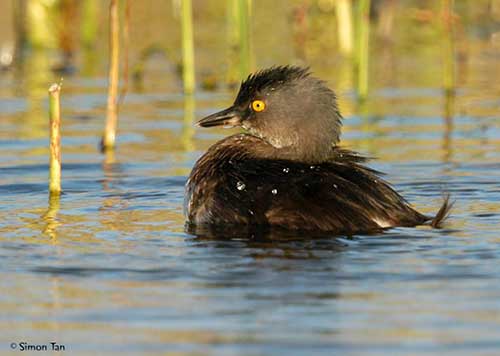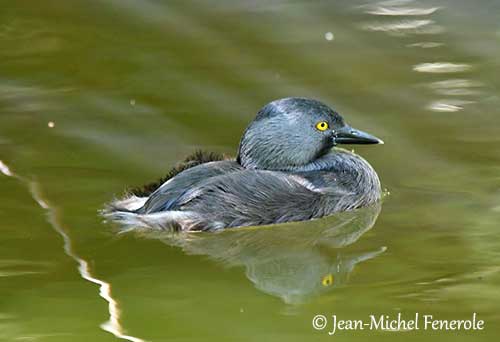
Fr: Grèbe minime
Ang: Least Grebe
All: Schwarzkopf-Zwergtaucher
Esp: Zampullín Macacito
Ita: Tuffetto minuto
Nd: Amerikaanse Dodaars
Sd: dvärgdopping
Photographers:
Roger Ahlman
Pbase Galleries Peru and Ecuador
Jean Michel Fenerole
Photos d’Oiseaux du monde
Tom Grey
Tom Grey's Bird Pictures & Tom Grey's Bird Pictures 2
Patrick Ingremeau
TAMANDUA
Simon Tan
PBase Bird galleries
Philippe and Aline Wolfer
OISEAUX D'ARGENTINE
Text by Nicole Bouglouan
Sources:
HANDBOOK OF THE BIRDS OF THE WORLD vol 1 by Josep del Hoyo-Andrew Elliot-Jordi Sargatal - Lynx Edicions - ISBN: 8487334105
Birds of Central America: BELIZE, GUATEMALA, HONDURAS, EL SALVADOR, NICARAGUA - De Andrew C. Vallely, Dale Dyer – Editeur: Princeton University Press, 2018 – ISBN: 0691138028, 9780691138022 - 584 pages
What Bird-The ultimate Bird Guide (Mitchell Waite)
"Fanning" Behavior and Nesting Biology of the Least Grebe
Observations of Least Grebe Foraging and Parental Care Behaviors
South Dakota Birds and Birding – (Terry L. Sohl)
The Texas Breeding Bird Atlas Project
Wikipedia, la enciclopedia libre
Least Grebe
Tachybaptus dominicus
Podicipediformes Order – Podicipedidae Family
INTRODUCTION:
The Least Grebe is the smallest member of the family Podicipedidae. It is found from SW USA and Mexico to Argentina, but also on islands including Trinidad and Tobago, the Bahamas and the Greater Antilles. This species is the only New World representative of the genus Tachybaptus.
It frequents both fresh and brackish waters and it is usually observed in small ponds or lakes, ditches, marshes and slow-moving rivers. It feeds primarily on insects of various species, and also consumes siders, tadpoles, crustaceans and small fish taken after underwater pursuit or above the surface.
The nest is built in shallow water and is typically made of decaying vegetation. This is a floating structure or anchored to aquatic plants.
The Least Grebe is not globally threatened, despite experiencing several predators, both aquatic and flying ones.

DESCRIPITON OF THE BIRD:
Biometrics:
Length: 23-25 cm
Wingspan: 48-53 cm
Weight: 128 g
The Least Grebe is a compact, small grebe with short, pointed bill, small head and slender neck.
The breeding adult has dark grey plumage. The crown is darker whereas face and neck show some purple-grey sheen. Flanks and rectrices are whitish with wispy feathers.
The bill is black with reduced whitish tip. The eyes are yellow to bright orange-yellow. Legs and lobbed feet are dull black.
Male and female are similar.
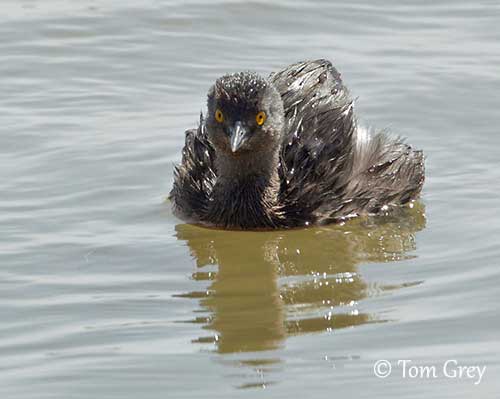
The non-breeding adult is paler, mostly greyish-brown with whitish throat. The bill is slightly paler. The backside is whitish and often fluffy.
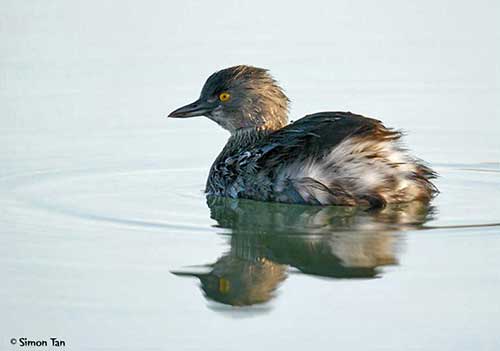
The juvenile resembles non-breeding adult with irregular whitish stripes on head sides and nape. Chin and throat are white. The bill is pale grey. The eyes are pale greenish-yellow.
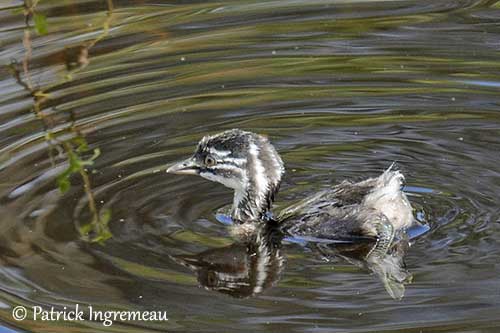
SUBSPECIES AND RANGE:
The Least Grebe has five subspecies.
T.d. dominicus (described above) is found in N Caribbean to Virgin Islands and N to Bahamas.
T.d. brachypterus occurs in WC Mexico and S Texas, S to Panama.
T.d. bangsi is found in S Baja California.
T.d. brachyrhynchus occurs in South America from Colombia, Venezuela, Trinidad and Tobago, S to N Argentina and S Brazil. This race is synonymous with T.d. speciosus.
T.d. eisenmanni is found in W Ecuador.
HABITAT:
The Least Grebe frequents small freshwater ponds and lakes with emergent and aquatic vegetation. But it is also found on temporary ponds and brackish wetlands or mangrove swamps, and in slow-moving rivers, especially in tropics. It is rarely observed on saltwater. The species is visible up to 2,500 metres of elevation in Mexico.
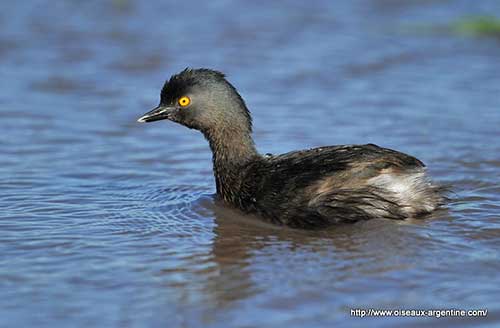
CALLS AND SONGS: SOUNDS BY XENO-CANTO
The Least Grebe gives a loud, nasal, single-note “beep” when threatened. The contact call is a soft “gup” between mates at or near the nest. The advertising call is a high-pitched “gamp”.
When together, both mates produce trills often ending in duet. Both adults trill together but with alternating notes. These calls serve to maintain the pair-bond all year round.
At nest, when an intruder is approaching, the adult gives a rapid “beep-beep-beep” rising and falling in intensity following intruder’s movements.

BEHAVIOUR IN THE WILD:
The Least Grebe feeds mainly on insects such as aquatic beetles, waterbugs, dragonflies’ adults and larvae and other arthropods. But it also takes other prey such as small fish and crustaceans, tadpoles and spiders.
When foraging, it dives and pursues a prey by swimming underwater. Insects are caught on and above the water surface, but also from the vegetation of the shore.
Dragonflies are caught in different way. The Least Grebe approaches the flying dragonfly by swimming underwater, before to erupt from beneath the surface to snatch it from the air.
The prey is usually swallowed immediately, but larger items are softened in the bill before consumption.
Like other grebes, it also eats some feathers, usually from its own plumage, in order to protect the digestive tract from sharp bones.

The Least Grebe forms monogamous pairs, and courtship displays are performed at any time of the year.
During the displays, the male swims along with raised head and sleeked body plumage, whereas the white fluffy flank and tail feathers are raised just above the water surface. This display is accompanied by loud, high-pitched “gamp”.
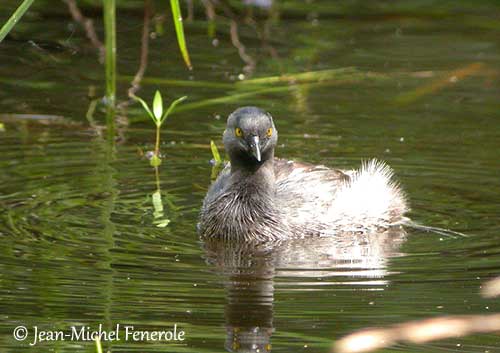
Like the larger species, both mates also perform a “rushing ceremony” during which male and female raise up suddenly while in the water and race forwards several metres before to drop to the water. A loud, nasal call can be heard during this display. They also perform low flights over the water.
The Least Grebe nests on floating or anchored platform. Both parents share the nesting duties.
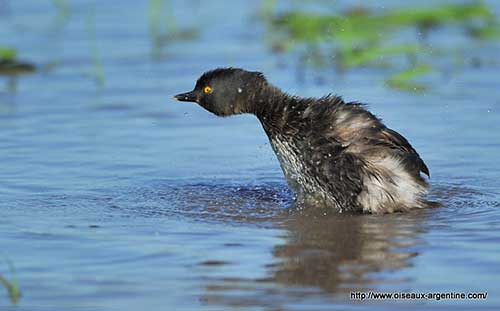
This species is mainly sedentary, but dispersal is observed, related to water levels.
The Least Grebe seems to fly more readily than other grebes. Following some running over the water surface, the flight is direct with powerful, rapid wingbeats.
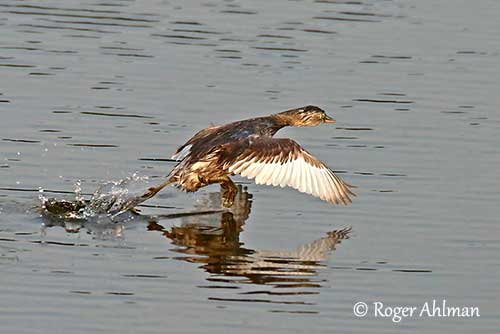
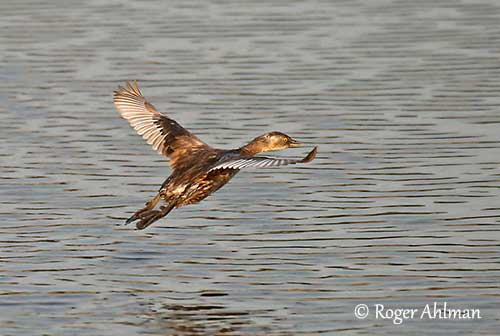
REPRODUCTION OF THIS SPECIES:
The Least Grebe can breed all year round, depending on the range and local conditions.
Both mates build the nest in shallow water, often near the shore. This structure is a mass of decaying vegetation usually anchored to aquatic plants or to the bottom, but it can be floating too. The nest is often reused for several broods.
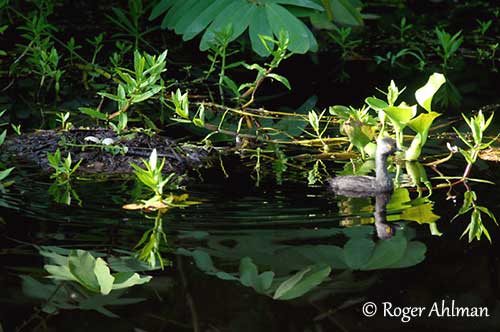
The female lays 4-6 whitish to pale blue-green eggs. They become quickly stained with the wet vegetation of the nest. Both adults share the incubation during 21 days. At hatching, the chicks are covered with black-and-white down. They can swim soon after hatching, but they often ride on adults’ backs. Within 40 minutes, they are able to cling to their mother when she dives. They are fed by both parents.
During the two weeks following the hatching, the young often return to the nest for resting and sleeping.
This species may produce 2-3 broods per year, but probably more in tropics.
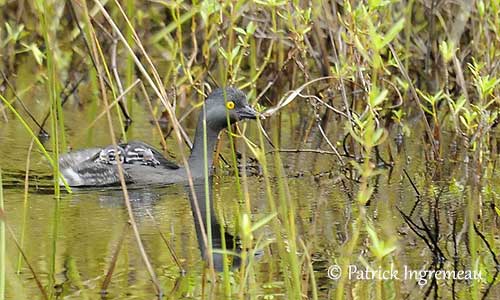
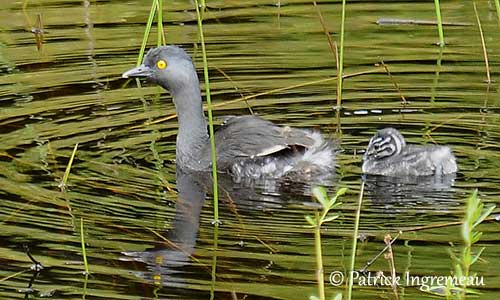
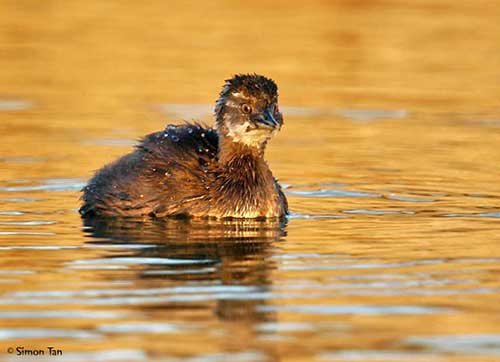
T.d. brachypterus
Immature
PROTECTION / THREATS / STATUS:
The Least Grebe is sensitive to habitat loss caused by drainage and water quality issues, as it depends on freshwater wetlands. Several predators such as large fish and sea turtles take the chicks, but also Raptors such as Aplomado Falcon can kill the adults.
The overall population size is unknown, but it is suspected to be stable, and even increasing in North America.
The Least Grebe is not globally threatened and the species is currently evaluated as Least Concern.
